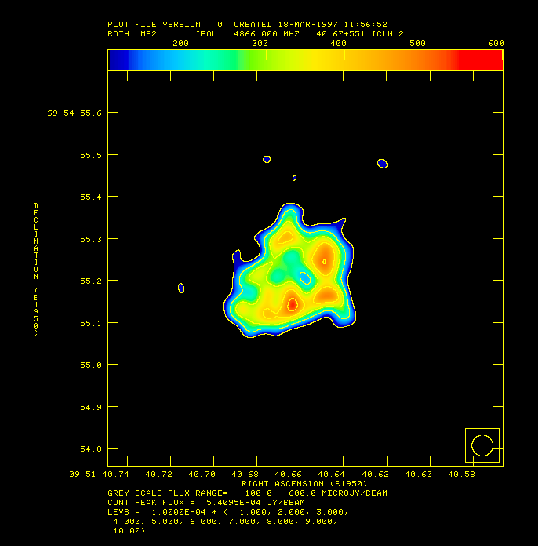

A team of UK radio astronomers at Jodrell Bank ( University of Manchester)
have been able to look into the dusty central regions of one of the nearest
``starburst'' galaxies (M82) and study both the physics of exploding stars
and probe the detailed anatomy of the galaxy. Because it is so close to
us (only 10 million light years) M82 provides a unique laboratory for studying
this starburst phenomenon. The results will shed light on similar processes
which must have occurred in the young galaxies, some of which may in the
process of forming, recently discovered by the Hubble Space Telescope.
Starburst galaxies are uncommon among the local population but much earlier in the history of the universe the majority of galaxies were undergoing rapid bursts of star formation as they were forming, a billion and more years after the Big Bang. Unfortunately the Hubble Space Telescope is not much use for studying M82, since the dust, or cosmic smoke, blown off as winds during the lifetime of previous generations of stars, completely obscures the place where new stars are being formed. Radio waves, on the other hand, are unaffected by the dust and therefore enable us to look directly into M82's heart. Paradoxically it is their spectacular deaths as supernovae that give the clues to the unusual behaviour of the central population of stars. The Manchester radio astronomers have been able to identify the remnants of about 50 supernovae all of which exploded within the last thousand years --- over ten times the rate at which supernovae explode in normal galaxies like our own. Using MERLIN they have been able to zoom in on individual remnants and show that they have the characteristic spherical shell--like structure of many supernova remnants in our own Galaxy. While the whole concept of the starbursting phenenomenon has been widely accepted in the astronomical community the Manchester results provide the first direct proof that it is correct.
In a recent development MERLIN absorption measurements against the individual supernova remnants are being used to probe the ionised, atomic and molecular gas in the interstellar medium of M82 on scales of order one light year. Each supernova remnant provides unique sample of the interstellar medium along the line of sight between the remnant and the observer. This information will be used to constrain the dynamics and distribution of the ambient gas in M82, and hence give information on the cause of the starburst phenomenum in M82 and other active galaxies.
The false colour radio image shows a region about 3000 by 2000 light
year across. It was made by combining data from the UK's MERLIN (Multi--Element
Radio--linked Radio Interferometer -- operated by the University of Manchester
on behalf of PPARC), with data from the US Very Large Array (VLA). The
two radio arrays complement each other nicely. The VLA has lower resolution
but is more sensitive to the diffuse emission while MERLIN has higher resolution
which enables the point--like supernova remnants to be discerned and then
to zoom in to map their quasi- shell--like structures. While these remnants
are only up to 1000 year old we believe that the diffuse emission is the
sum of lots of older remnants which exploded up to 10,000,000 years ago.

